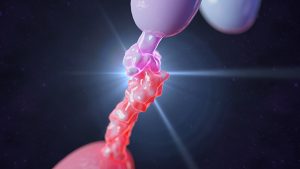PUBLICATION
Rony Dahan, Emanuela Sega, John Engelhardt, Mark Selby, Alan J. Korman, and Jeffrey V. Ravetch, FcγRs Modulate the Anti-tumor Activity of Antibodies Targeting the PD-1/PD-L1 published in Cancer Cell.
PUBLICATION SUMMARY
 Tumor cells are known to evade the immune system via expression of PD-L1 with antibody blockade of the PD-1/PD-L1 axis resulting in therapeutic responses across tumor types. The interaction of the fragment crystallizable (Fc) domain of therapeutic antibodies with Fcg receptors (FcgRs) has been shown to play a role in therapeutic activity. In this study, a group of researchers led by Dr. Jeffrey Ravetch at Rockefeller University investigated the impact of Fc and FcgRs interactions in the efficacy of PD-1 and PD-L1 antibodies.
Tumor cells are known to evade the immune system via expression of PD-L1 with antibody blockade of the PD-1/PD-L1 axis resulting in therapeutic responses across tumor types. The interaction of the fragment crystallizable (Fc) domain of therapeutic antibodies with Fcg receptors (FcgRs) has been shown to play a role in therapeutic activity. In this study, a group of researchers led by Dr. Jeffrey Ravetch at Rockefeller University investigated the impact of Fc and FcgRs interactions in the efficacy of PD-1 and PD-L1 antibodies.
Type I FcgRs are present as either activating receptors or inhibitory receptors with effector responses being mediated by the ratio of activating-to-inhibitory receptor binding. Increasing activator binding of the Fc portion of therapeutic IgGs can increase their therapeutic response. To test the role of FcgR binding in response to PD-1 and PD-L1 antibodies, the researchers created chimeric antibodies joining the Fab domain of existing rat antibodies and mouse Fc domains with different binding affinities for FcgRs. They discovered that the ability of PD-L1 antibodies to produce an anti-tumor response is dependent on Fc engagement with FcgRs. The chimeric antibody with preferential binding to inactivating FcgRs and a null variant lacking ability to bind FcgRs were less able to thwart tumor growth in mouse models than a chimeric antibody with high activating receptor binding. In contrast to this finding, the anti-PD-1 chimeric antibodies were not dependent on FcgR binding. In fact, these antibodies exhibited stronger anti-tumor activity in the absence of activating FcgR binding capabilities.
The group next turned their attention to the mechanism of the activating FcgR requirement for PD-L1 antibody activity by utilizing a mutant mouse lacking all activating FcgRs but retaining expression of the inhibitory FcgRIIb. Compared to wild type mice, this mutant showed less response to PD-L1 antibodies, again underscoring the importance of activating FcgRs in PD-L1 antibody response. By studying the splenic and tumor-infiltrating myeloid populations of these mice, the researchers were able to show that myeloid subsets within the tumor microenvironment were altered by activating FcgR interactions and activating FcgRs play a role in mediating depletion of immunosuppressive cells. Additional experiments showed activating FcgRs reduce the efficacy anti-PD-1 antibodies via reduction of CD8+ cells in the tumor microenvironment.
In this study, researchers demonstrated that PD-L1 and PD-1 antibodies have distinct FcgR requirements for optimal activity. This research highlights the value of considering Fc domain interactions in research and development of therapeutic antibodies.
FEATURED PRODUCTS:
The following Bio X Cell Antibodies are Featured in the Publication:
- InVivoPlus anti-mouse PD-1 (CD279) Clone: RMP1-14, Catalog #: BP0146
- InVivoPlus anti-mouse PD-L1 (B7-H1), Clone: 10F.9G2™, Catalog #: BP0101
- InVivoPlus mouse IgG1 isotype control, unknown specificity, Clone: MOPC-21, Catalog #: BP0083
- InVivoPlus mouse IgG2a isotype control, unknown specificity, Clone: C1.18.4, Catalog #: BP0085
- InVivoPlus rat IgG2b isotype control, anti-keyhole limpet hemocyanin, Clone: LTF-2, Catalog #: BP0090
- InVivoPlus rat IgG2a isotype control, anti-trinitrophenol, Clone: 2A3, Catalog #: BP0089
Recombinant Antibody Alternatives Offered at Bio X Cell
- RecombiMAb anti-mouse PD-1 (CD279), Clone: RMP1-14-CP162, Catalog #: CP162
- RecombiMAb anti-mouse PD-1 (CD279), Clone: RMP1-14-CP157, Catalog #: CP157
- RecombiMAb anti-mouse PD-1 (CD279) (D265A), Clone: RMP1-14-CP002, Catalog #: CP002
- RecombiMAb anti-mouse PD-L1 (B7-H1), Clone:10F.9G2™-CP168, Catalog #: CP168
- RecombiMAb anti-mouse PD-L1 (B7-H1) (D265A), Clone:10F.9G2™-CP001, Catalog #: CP001
